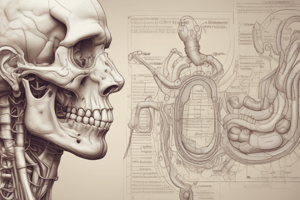Podcast
Questions and Answers
What is the average number of cells in an adult human body?
What is the average number of cells in an adult human body?
more than 100 trillion
Which of the following are functions of the cell? (Select all that apply)
Which of the following are functions of the cell? (Select all that apply)
Cells can communicate with each other through chemical and electrical signals.
Cells can communicate with each other through chemical and electrical signals.
True (A)
What are the specialized structures within a cell that perform specific functions called?
What are the specialized structures within a cell that perform specific functions called?
Signup and view all the answers
What component of the plasma membrane comprises 75% of its composition?
What component of the plasma membrane comprises 75% of its composition?
Signup and view all the answers
What is the role of the plasma membrane?
What is the role of the plasma membrane?
Signup and view all the answers
The polar part of a lipid is called the ______.
The polar part of a lipid is called the ______.
Signup and view all the answers
The hydrophobic tails of phospholipids face outward toward the extracellular fluid.
The hydrophobic tails of phospholipids face outward toward the extracellular fluid.
Signup and view all the answers
What term is used for the specific molecules that bind to receptors on cell membranes?
What term is used for the specific molecules that bind to receptors on cell membranes?
Signup and view all the answers
Which protein type extends into or through the lipid bilayer?
Which protein type extends into or through the lipid bilayer?
Signup and view all the answers
Study Notes
Cellular Level of Organization
- The adult human body contains over 100 trillion cells, serving as the basic structural and functional units.
- Cells are highly organized and contain specialized structures called organelles that perform specific functions.
Functions of Cells
-
Cell Metabolism and Energy Use:
- Metabolic energy supports cell activities such as molecule synthesis, muscle contraction, and heat production for temperature maintenance.
-
Synthesis of Molecules:
- Cells synthesize proteins, nucleic acids, and lipids, determining their structural and functional characteristics.
-
Communication:
- Cells communicate via chemical and electrical signals (e.g., nerve cells stimulating muscle contraction).
-
Reproduction and Inheritance:
- Each cell carries genetic information, with specialized cells such as sperm and oocytes involved in reproduction.
Plasma/Cell Membrane
- The plasma membrane is a flexible, sturdy barrier surrounding cytoplasm, separating extracellular from intracellular substances.
- It acts as a selective barrier controlling the movement of substances in and out of the cell and facilitates intercellular communication.
Structure of the Plasma Membrane
-
Lipid Bilayer:
- Composed of three lipid types:
- Phospholipids (75%): Contain phosphorus, forming the bilayer structure.
- Cholesterol (20%): A steroid with a hydroxyl (-OH) group, providing stability.
- Glycolipids (5%): Lipids with carbohydrate groups attached.
- Lipids are amphipathic, featuring both hydrophilic (polar) heads and hydrophobic (non-polar) fatty acid tails.
- Composed of three lipid types:
-
In the bilayer, hydrophilic heads face outward toward cytosol and extracellular fluid, while hydrophobic tails are oriented inward, forming a nonpolar region.
Membrane Proteins
-
Integral Proteins:
- Extend through the lipid bilayer, with transmembrane proteins spanning the entire bilayer.
-
Peripheral Proteins:
- Loosely attached to the lipid heads or integral proteins, located on either membrane surface.
Functions of Membrane Proteins
-
Ion Channels (Integral Proteins):
- Create pores for specific ion passage (e.g., potassium ions), typically allowing only one type of ion through.
-
Carriers/Transporters (Integral Proteins):
- Transport polar substances or ions across the membrane selectively.
-
Receptors (Integral Proteins):
- Recognize and bind specific molecules (e.g., insulin receptors bind insulin).
-
Enzymes (Integral and Peripheral Proteins):
- Catalyze biochemical reactions essential for cell function.
Studying That Suits You
Use AI to generate personalized quizzes and flashcards to suit your learning preferences.
Related Documents
Description
This quiz focuses on the cellular level of organization within human anatomy and physiology. It covers the fundamental concepts of cells being the basic living units of the body, along with their specialized structures called organelles. Test your understanding of cell functions and their significance in the human body.




